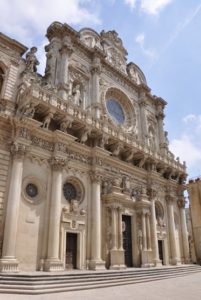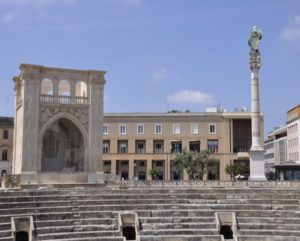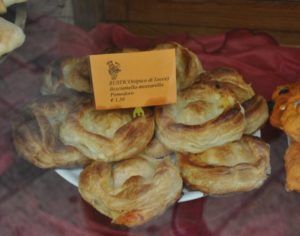 After a few days lounging by the pool and beach at Masseria Torre Coccaro and touring towns of Valle d’Itria, we drove south to explore the splendors of the Salento region, often considered the third island of Italy because it’s very hot, dry and lined with beaches.
After a few days lounging by the pool and beach at Masseria Torre Coccaro and touring towns of Valle d’Itria, we drove south to explore the splendors of the Salento region, often considered the third island of Italy because it’s very hot, dry and lined with beaches.
Lecce
Our first stop was the capital of the Salento region sitting in the middle of Italy’s boot heel. Known as the ‘Florence of the south’ for its spectacular of baroque architecture, Lecce is a gem to visit and I was looking forward to it as I love Florence.
When you enter the Old Town, you can immediately see the similarities with Florence. Great news is you can explore the treasures of this small town’s Centro Storico (historic center) in just a few hours. We parked just outside the Old Town next to the Lecce’s Castello, 16th century Norman Castle, and entered at the famous Piazza Sant’Otranto, the town’s main bustling area.
Here sits the remains of a 2nd century 15,000 seat Anfiteatro discovered in a 1930 excavation. Only half of the Roman Amphitheatre can be seen today but is quite a ‘welcome’ to town. Standing over the amphitheater is the Colonna di Sant’Oronzo, a 115-foot tall column, dedicated to the city’s patron Saint Oronzo, said to have cleansed the region of a plague in the 17th century. This very column was one of two that marked the end of the Appian Way in Brindisi. Also in the Piazza you see your first of the town’s forty churches.
 The most well known of the churches and THE baroque spectacular is Basilica di Santa Croce. Built in the 15th century, it took a team of craftsmen lead by the town’s famous Giuseppe Zimbalo over 100 years to ornament the church with gobs of baroque sculptures finishing in the 17th century. Baroque architecture exploded in the region from the 17th to 18th century as a celebration to the end of the Turkish invasion and saving of the Roman Catholic faith. The stone figures adorning Santa Croce, and structures throughout town, are made from the local stone, pieta leccese, soft and easy to sculpt. Lean up against the wall across from the Basilica and take in the intricate details of saints, angels, animals, fruit and flowers.
The most well known of the churches and THE baroque spectacular is Basilica di Santa Croce. Built in the 15th century, it took a team of craftsmen lead by the town’s famous Giuseppe Zimbalo over 100 years to ornament the church with gobs of baroque sculptures finishing in the 17th century. Baroque architecture exploded in the region from the 17th to 18th century as a celebration to the end of the Turkish invasion and saving of the Roman Catholic faith. The stone figures adorning Santa Croce, and structures throughout town, are made from the local stone, pieta leccese, soft and easy to sculpt. Lean up against the wall across from the Basilica and take in the intricate details of saints, angels, animals, fruit and flowers.
 Via Vittorio Emanuele is the main street running through Old Town. Walking from Piazza Sant’Otranto you’ll come upon Piazza Duomo mid-way then at the other end stands one of the gorgeous three remaining old entry gates to the town. Also along Vittorio Emanuele you’ll find lots if shops, cafes and bakeries. There are many chances to pick up the town’s famous papier-mâché figurines. We LOVED La Rusticana (Via Vittorio Emanuele, 31) that while doesn’t look like much has incredible pastries like the Rustica, the yummiest flaky pastry shaped like a cinnamon roll filled with mozzarella cheese, tomatoes and a little béchamel sauce. YUM! There’s also a cool enoteca / bookstore / restaurant, Liberrima, which is worth the visit.
Via Vittorio Emanuele is the main street running through Old Town. Walking from Piazza Sant’Otranto you’ll come upon Piazza Duomo mid-way then at the other end stands one of the gorgeous three remaining old entry gates to the town. Also along Vittorio Emanuele you’ll find lots if shops, cafes and bakeries. There are many chances to pick up the town’s famous papier-mâché figurines. We LOVED La Rusticana (Via Vittorio Emanuele, 31) that while doesn’t look like much has incredible pastries like the Rustica, the yummiest flaky pastry shaped like a cinnamon roll filled with mozzarella cheese, tomatoes and a little béchamel sauce. YUM! There’s also a cool enoteca / bookstore / restaurant, Liberrima, which is worth the visit.
One of the town’s best restaurants is Alle Due Corti (1 Corte die Giugni) specializing in traditional pugliese cuisine like  La Taieddha (layered potatoes, rice and mussels baked). The very well known and well regarded cooking school, Awaiting Table, is also located in Lecce.
Note the shops bolt up from approximately one to four in the afternoon. So we headed out after our light lunch from La Rusticana.
 Gallipoli
Gallipoli
From Lecce we drove east to the Ionian Coast then south down the local roads along the gorgeous beaches in route to Gallipoli. We stopped along the way in Santa Caterina‘s square for an espresso and aperitif. This cute little village on the sea is very popular for divers who want to explore the many rock caves in the area.
Greek influence in strong in the Salento region… you’ll find towns named Calimera, meaning ‘good morning’ in Greek, and Gallipoli, from Greek Kale polis meaning ‘beautiful city.’ And beautiful it is.

We entered at the harbor just outside the town walls with the later afternoon sun beating down on the colorful boats parked around the castle entrance. Passing the fish market we made our way up into the Old Town to Corso Roma, the town’s main street. There are fourteen churches in this tiny town. We strolled the streets and ramparts then sat down on bar stools at La Spingula wine bar for a few glasses of local Rosato enjoying the sun and views of fishing boats on teh water coming in with their day’s catch. Ready for dinner we made our way around to Trattoria Scoglio delle Sirene (Riviera N. Sauro, 83) for the town’s specialty seafood cooked up with fresh local pastas as we watched the sunset into the Ionian Sea.
A perfect end to our tour of Puglia’s unique towns…Alberobello, Ostuni, Locorotondo, Lecce and Gallipoli!


